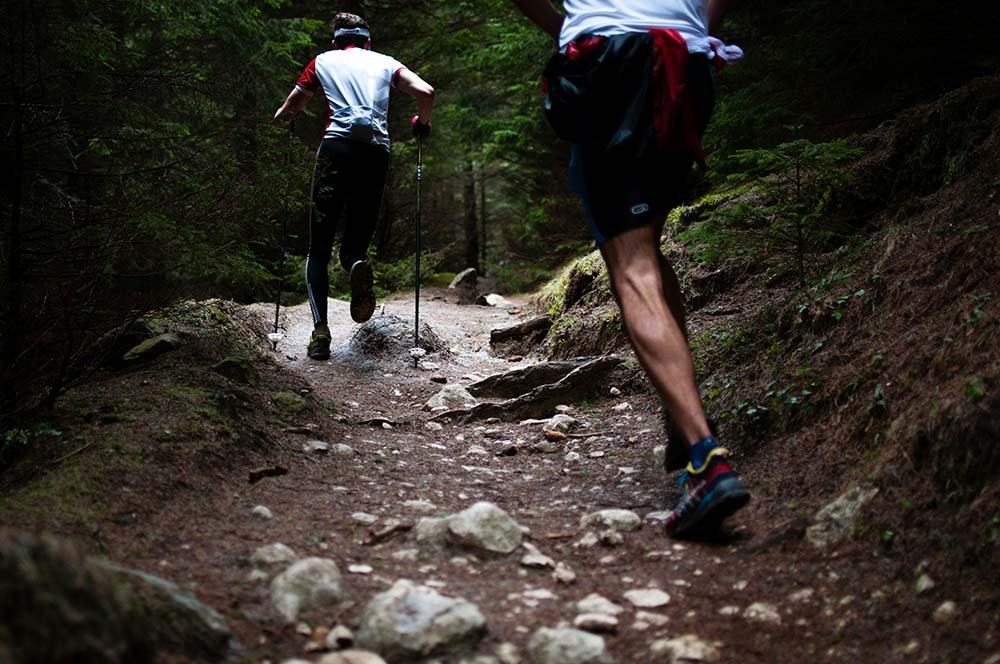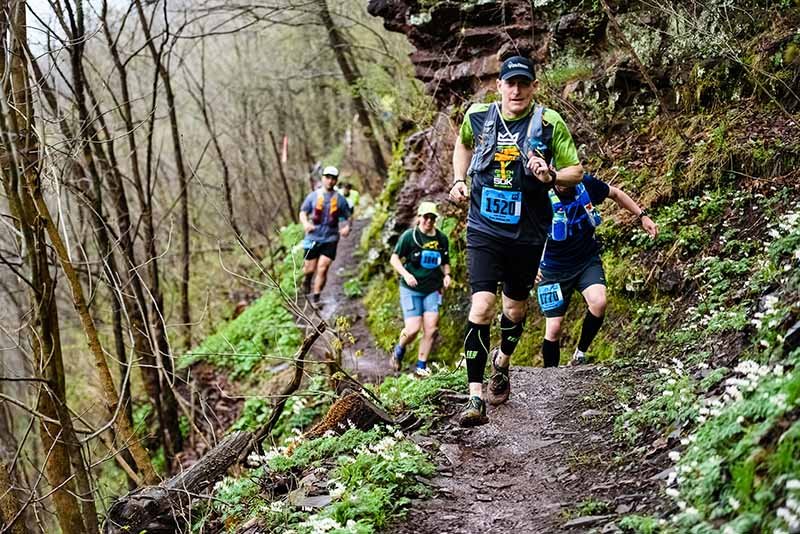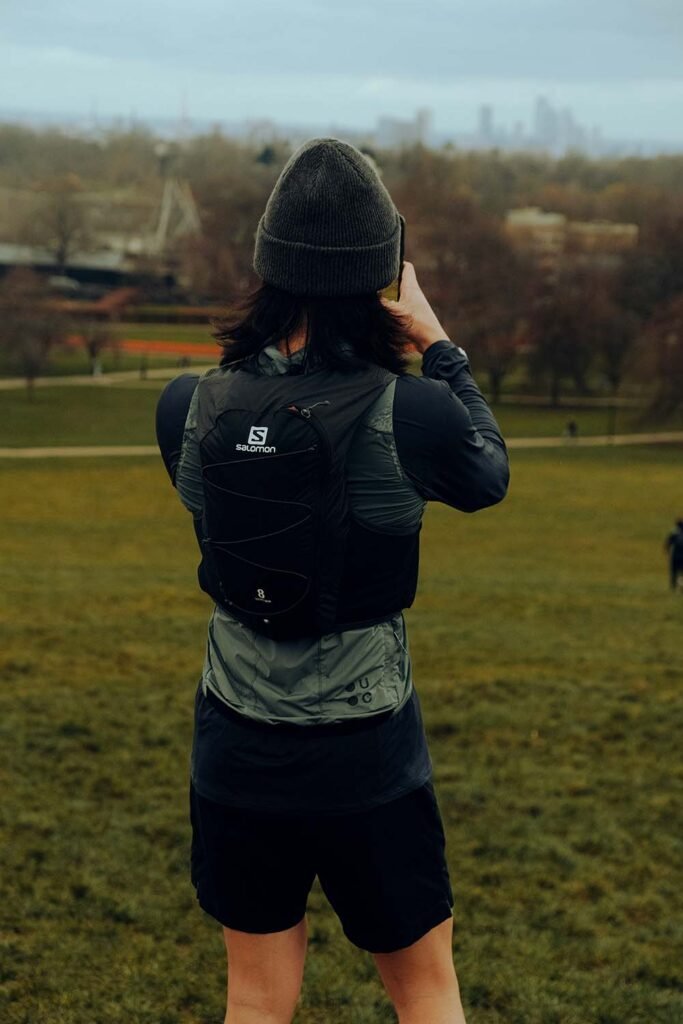Trail running is one of the most rewarding ways to explore the outdoors, but without the right gear, it can go from exhilarating to miserable real quick. Whether you’re out for a quick 10km hit or pushing through a 100km ultra, having the right kit makes all the difference.
Want to know what to wear on a trail run? Head over to our What to wear trail running? blog post!
Almost a different activity to road running, slogging it on trails presents unique challenges: steep climbs, rocky descents, sloppy surfaces and weather with a lot of different moods—all of this in very remote terrain. Following our essential list of trail running gear will keep you comfortable, efficient and safer on the trail, letting you enjoy the run rather than suffer through it.
Skip to:
What gear do you need for trail running?

The gear you need depends on the distance, terrain and weather conditions. We’ve broken up the essential trail running gear by distance and then by conditions.
Up to half marathon
For runs under 21km, you don’t need much beyond the basics, but a few key items can make your run more enjoyable and safe.
- Trail running shoes suited for the terrain (don’t go all out on the best gear if you’re unsure whether trail running is your thing yet)
- Running shorts or leggings (weather-dependent)
- Moisture-wicking top to prevent chafing and overheating
- Hydration (handheld bottle or small running vest)
- Sun protection (cap, sunglasses, sunscreen applied well before the race to prevent it running into your eyes)
- Basic first aid (small kit with band-aids, blister patches and emergency details)
- Headlamp (if running super early or late)
- Energy gels or snacks (make sure you train using these, as they’re sometimes icky on the novice’s gut)
- Anti-chafing balm (need we say more)
While you don’t need a pack or vest for shorter trail runs or races, it’s still worth considering if you’re running in remote areas or in unpredictable conditions.
If you’re starting out with trail running, ease into carrying gear. A lightweight running belt with a small flask and a gel or two is often enough. As you build endurance and go for longer distances, start using a running vest to get used to carrying weight.
Up to 50km ultra
Okay, now that you’re stepping beyond the half marathon, things change. You need to carry more gear to sustain yourself over longer distances and be prepared for varying conditions.
- Hydration vest or running pack (1-2L fluid capacity)
- Electrolytes and nutrition (gels, chews, nuts, sandwiches)
- Lightweight waterproof jacket (weather-dependent)
- Emergency whistle and space blanket (critical if you’re going far off-grid)
- Fully charged phone (keep it in a ziplock bag to avoid sweat, rain or debris destroying it)
- Buff or lightweight gloves (if winter trail running or heading into high altitudes)
- Body glide or anti-chafing balm (not vaseline, it wears off way too quick)
- Extra socks (wet feet = blisters)
- Small first aid kit with essentials like blister pads, antiseptic wipes and pain relief
- Trekking poles (if the route has solid elevation gain)
At this distance, preparation is key. You don’t want to get caught out in bad weather or run out of fuel when you still have hours left to go. Also, practise running with your full kit well before race day. A heavy vest changes your balance and posture, and also introduces more chafing—so get used to it on training runs.
100km ultra and beyond

For 100km-plus ultras, safety and endurance are the priorities. You’re getting into the most extreme running distances now, and people often collapse or DNF because of poor preparation. These distances push the body and mind to the limit, and your gear should support you through the highs and lows (which I guarantee will come).
- Hat, gloves and a warm layer
- Emergency bivvy bag for unexpected overnight stays or quick naps on the side of the trail
- Map and compass or GPS device
- Garmin InReach Mini (I love this device, great for remote areas with no phone reception)
- Headlamp and spare batteries
- Trekking poles (if the route is mountainous)
- Emergency food stash in case you run low
- Toilet paper in a ziplock bag (thank me later)
- Extra socks and a dry base layer
- Full waterproof body cover (jacket and pants, if the conditions call for it)
Ultras often require drop bags at aid stations, so planning what you need at each stage is crucial. You’ll likely have a support crew on the super long races, so this would’ve (should’ve) all been discussed well in advance. You won’t regret taking caffeine gels or salt tablets to stay alert and maintain electrolyte balance, but as always, train with these first to make sure they sit right with you.
Lastly, if your ultra involves long night sections, test your headlamp in advance. Some trails have no artificial light at all, and running in pitch black will almost definitely get you lost.
Seasonal gear advice for Aussie summers and winters
Of course, another major factor in must have trail running gear is the weather and time of year. Australia’s diverse climate demands adaptable gear choices to tackle the varying conditions of summer and winter.
Summer essentials
Australian summers can be brutal, with sky-high temperatures and scorching sun all season long. On the west coast, we tolerate temps in the 35-degree to 40-degree range, and regional areas where most trail races are held can get even spicier.
To stay comfortable and protected on the trails in the harsh Aussie summer, make sure you’ve got the right gear:
- Lightweight, breathable clothing: Opt for moisture-wicking fabrics that promote ventilation, keeping you as cool as possible.
- Sun protection: A running cap, UV-blocking sunglasses and high-SPF sunscreen shield you from harmful rays.
- Hydration solutions: A hydration vest or belt with ample capacity ensures you stay hydrated during long runs (see our section on hydration systems for more info).
- Trail running shoes with ventilation: Shoes designed with breathable materials prevent overheating and reduce moisture buildup.
- Socks with good moisture management: Whether merino wool or structurally modified fibers that wick moisture away, ensure you choose the right socks in the heat that still provide enough cushion (IOW don’t just go for thin socks). You can find more on sock choice in our post on what to wear while trail running..
Winter essentials
While Australian winters are milder, certain areas of the country can experience brutally cold and wet conditions—especially in the mountains or hills. But you can combat the cold in winter with a few trail running essentials:
- Thermal base layers: Merino wool or synthetic thermals provide insulation while wicking moisture away.
- Waterproof and windproof jacket: A lightweight, seam-sealed jacket is key to fend off rain and wind.
- Full-fingered gloves and beanie: Keep your extremities warm to keep in your body heat. You might whip these off later in the race, in which case they’re small enough to conveniently pop in your pack or pockets.
- Trail shoes with grip: Enhanced traction is vital for muddy or slippery trails common in winter. Make sure you spend the time researching the right shoes for your planned trail run.
The best snacks and foods to take trail running
Fueling on the trails can be tricky—what works for one runner mightn’t for another. You’re probably picking this up by now but test different foods during training to find what your stomach can handle. Sometimes it even comes down to flavours, with some being too sweet or not sweet enough, too chocolatey, too coffee-y… you get the picture.
Here are some of my favourite snack ideas for the trail:
- Gummy bears (awesome for quick sugar boosts)
- Salted mashed potatoes (real food alternative to gels)
- Peanut butter sandwiches (great mix of carbs and protein)
- Energy bars (buy ones that won’t melt in heat)
- Salt tablets or pretzels (to replace lost sodium throughout the run)
- Dates or dried fruit (natural energy without the large blood sugar spikes)
Keep your snacks in easy-to-reach pockets and ideally in zip lock bags. The last thing you want during a race is to stop and rummage through your pack for food, so know your pack inside out and be blindly able to retrieve your goodies.
Running belt vs vest

The case for running belts
A running belt is great for short runs, and even up to half marathons or marathon distances you might get away with just a belt. You can attach your important items to the many loops that usually come with them and you can usually slide in a small water bottle (if you’re not wearing one on your hand or relying on aid stations for hydration).
Just remember that smartphones are very bulky these days, so consider how badly you need it if the race is only short. This would free up a lot of space in your pack, and if you’re deadset on recording your route, you can consider a Garmin or smart watch to track your race.
The case for running vests
But if you’re carrying more than water and a gel, a vest is the likely way to go. Vests these days can be found incredibly lightweight without breaking the budget. Their ventilation is typically excellent, so you won’t feel hugged by an extra layer of clothing in hotter months. They also mean you can carry your extra goodies and not be weighed down with worry that you haven’t packed enough.
If you’re still unsure about what to buy, think about how much nutrition you’ll need, as well as what racing accessories are obligatory for your race or training run. If it’s only a gel or two, two small bottles of water, and you know you’ll have aid stations along the way, then you might be able to just get away with a running belt. If you’re out there for hours, then a vest is going to carry all of those nutrition suggestions we’ve given you, along with a range of clothing and accessories that you can attach.
Also, research the race FAQs. You might find they strongly suggest one or the other. At the end of the day, make sure you’re comfortable. And whichever you choose, a running belt vs vest, make sure you test them out on the trail prior to race day.
Choosing the right hydration pack for your trail run
Hydration packs come in different sizes to coincide with the distances you’ll be slogging.
If you’re running less than 20km, a handheld bottle might be enough, or a running belt with a small bottle inserted.
Longer distances? You’ll want a vest with room for 1-2L of water and storage for snacks and essentials.
What safety gear do I need?
Safety gear is not only crucial for your own wellbeing but is typically mandatory for serious races. Events like the Ultra-Trail Australia stipulate specific gear to ensure runners are prepared for emergencies and variable conditions.
Mandatory items might include waterproof jackets, thermal layers, whistles and emergency blankets. Competitors are put through official gear checks prior to race, and failure to meet these them can result in disqualification. It’s a serious part of trail running for a reason.
At the very least, for longer trail running events, add these to your pack:
- Reflective tape (for visibility)
- Whistle (most running vests have one built-in)
- First aid kit
- Fully charged phone (in a waterproof or ziplock bag)
- Headlamp (for early morning starts or night runs)
Do I need a Garmin or running watch?
Do you splash out on a fancy running watch, like a Garmin? Or save your several hundred dollars and focus on the race, your technique and getting all the right trail running gear?
Garmins and other types of running watches aren’t 100% necessary but they can be very helpful.
Avoid getting lost
GPS watches track your distance, elevation and pace and some even provide navigation. On a mapless run through the Perth Hills, I had to consult my Garmin to help me find my way back. It was after one of those I’ll-just-see-where-this-path-takes-me decisions, which I followed for far too long. The mercury was rising and if it wasn’t for zooming out on the map element of my Garmin, I would’ve been watching my heart rate rise and praying for a miracle. (I found my way out after 500m of bushbashing.)
Train smarter
Garmins and the like offer very accurate heart monitoring (I’ve checked this while at the doctor’s office, and my heart rate according to the doc was accurate as the thing on my wrist). This is excellent if you’re following an ultra or marathon training plan that promotes training within certain heart rate zones.
You can be alerted when you’re exceeding Zone 2 and the same for when you’ve dropped out of Zone 5. All that said, you can probably figure out the former when you can run and have a conversation and the former when it feels like your heart’s about to burn out of your chest.
If you’re serious about trail running, a watch with navigation, elevation tracking and heart rate monitoring (among many other cool functions) can be a game changer.
Comprehensive trail running checklist
A well-prepared trail runner considers all essentials for a safe and enjoyable experience:
Footwear:
- Trail running shoes suited to terrain and weather conditions
- Moisture-wicking, anti-blister socks
Clothing:
- Season-appropriate attire (lightweight for summer, thermal layers for winter)
- Waterproof and windproof jacket
- Hat, gloves, and buff or neck gaiter
Hydration and nutrition:
- Hydration pack or bottles with sufficient capacity
- Electrolyte supplements
- Energy gels, bars or real food snacks
Safety gear:
- Fully charged mobile phone in a waterproof bag
- Whistle
- Emergency space blanket or bivvy sack
- First aid kit
- Headlamp with spare batteries
- Map and compass or GPS device
Accessories:
- Sunscreen and insect repellent (to prevent “hitchhikers”, insects that latch on to your skin while you run)
- Trekking poles for technical or hilly terrain
- Ziplock bags with toilet paper and wet wipes
- Anti-chafing balm
- Cash or card for emergencies
Gear hacks
- Efficient packing: Use ziplock bags to organize and waterproof essentials like your phone, snacks and first aid items.
- Hydration maintenance: Freeze your hydration bladder overnight before hot runs to keep water cooler for longer.
- Preventing blisters: Aside from keeping your feet dry, Injinji toe socks—favored by athletes like Courtney Dauwalter—reduce toe friction and minimize blister formation.
- Chafing prevention: Apply anti-chafing balm to high-friction areas before running to reduce irritation and hotspots.
- Emergency preparedness: Wrap a small amount of duct tape around a trekking pole or bottle for quick gear fixes on the trail.
- DIY calf sleeves: Cut the tops off old compression socks to create lightweight, makeshift calf sleeves.
- Blister prevention tip: Apply KT tape to known hot spots before your run if you’re prone to blisters.
Ultimately, find what suits you and don’t overdo it!
Trail running is about freedom, not carrying a full survival pack on your back. Start with the essentials, refine your kit as you gain experience and enjoy the adventure.
Ultimately, the best trail running gear is the one that suits your personal needs, preferences and running environment. While lists and recommendations from pros are a great starting point, nothing replaces firsthand experience.
Test your gear on shorter runs before committing to it for long distances or races. Make small adjustments—experiment with different hydration vests, try various sock materials to prevent blisters and see what foods your stomach tolerates best on the trail.
Want more great tips like these straight from explorers’ mouths? Check out plenty more Gear & Tips articles to help sharpen your adventure nous.



